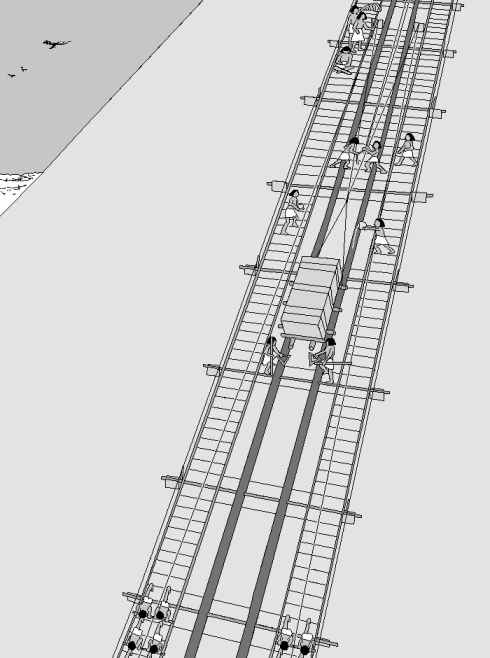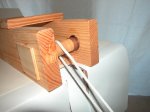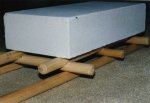How were the pyramids built? Using rope rolls and sledges on tracks.
A new method by Franz Löhner
Many methods for constructing the Great pyramids of Giza have been suggested. Ramps in all shapes and forms have been drawn, but so far no really good explanation, how this great feat was done has been found. Calculations show that a stone weighting 2.5 tons had to be moved up the pyramid of Khufu every 1 to 2 minutes, so the pyramid could be finished in a maximum of 20 years.
No more large construction ramps!
The German Franz Löhner [1] has thought of an impressively simple way how the ancient pyramid builders could have erected those large monuments - using wooden rope rolls and sledges on tracks installed directly on the flank of the pyramid. The rope roll is basically a small wooden stand with a wooden bearing (a cross beam) over which a rope can be deflected or turned around (details below).
 Main pages in English on www.cheops-pyramide.ch
Main pages in English on www.cheops-pyramide.ch
 Rope roll stations on the pyramid flank
Rope roll stations on the pyramid flank
A wooden track is constructed directly on the pyramid face and anchored on the casing. Two rope rolls are installed on both sides of the track and anchored on a special casing stone each. The two rope rolls constitute a rope roll station. A rope roll station is installed about every 30-37m height and an additional one on the edge to the pyramid plateau. On both sides of the track, a ladder-like rig is installed for the haulers to walk on. The stone block (weighting an average of 2.5 tons) is laid on a wooden sledge and tied down with ropes. The sledge is then installed on the tracks. Of course the tracks and the skids of the sledge are well lubricated with watered oil.
Rope roll station, tracks and haulers on pyramid flank
(illustration R. Zuberbühler)
Click here for version with detailed
explanation / print
version
Now the ropes which are attached to the sledge are brought up to the rope roll, slung over the cross-piece of the rope roll and left dangling. Two hauling teams (of 24 men each - calculations show a minimum of 46 men are necessary) are waiting on the top, standing in two groups on each side of the track on the top of the ladder-like rig just down from the rope roll station (reel station). To pull the stone up, the hauling teams are walking down the steep ladder-like rig on the pyramid flank. Two haulers together grab a crossbar handle (wooden toggle) attached to the rope and, holding it in front of their chest, they push. When they walk down, the sledge with the stone is carried up the tracks.
Once the sledge arrives at the edge of the pyramid frustum, it is tilted,
so it rests on the plateau and another hauling team takes over and transports
the stone to its intended position on the pyramid plateau. The sledge
is released and returned to its starting point in the stone quarry. The
hauling team meanwhile can return back to the rope roll station for their
next assignment, using a normal stairway which is installed for their
convenience.
![]() Transport up the pyramid
flank with Löhner's rope roll
Transport up the pyramid
flank with Löhner's rope roll
 Löhner's rope roll
Löhner's rope roll
 Why
build separate ramps when the pyramid has four inclined planes as an integral
part of its structure? Löhner's solution is a very simple device
- a so called rope roll or reel station. This rope roll is basically a
small wooden stand with a wooden bearing (a cross beam) over which a rope
can be deflected or turned around. Pairs of these rope rolls and tracks
for the sledges are installed directly on the pyramid flank (the illustration
also shows the ropes tying the rope roll down to the stone block) and
anchored to protruding casing stones.
Why
build separate ramps when the pyramid has four inclined planes as an integral
part of its structure? Löhner's solution is a very simple device
- a so called rope roll or reel station. This rope roll is basically a
small wooden stand with a wooden bearing (a cross beam) over which a rope
can be deflected or turned around. Pairs of these rope rolls and tracks
for the sledges are installed directly on the pyramid flank (the illustration
also shows the ropes tying the rope roll down to the stone block) and
anchored to protruding casing stones.
Because the ropes from the sledge are turned around and back down, the hauling teams can walk down on both sides of the track instead of walking up ahead of the sledge. By walking down they pull the sledge with the stone attached to it up the tracks.
Which principle is behind this? Because the haulers can add their own weight to their strength to pull the stone up, it is possible to accomplish this on the 52°-slope on the pyramid flank with teams of only 48 men. Without the rope roll to turn the rope, it would not be possible. Calculations show, that without the rope roll even on a moderate slope of only 5° you already need over 50 men to pull the same 2.5 tons stone block up.
| Rope roll (this smaller rope roll can carry about 1 ton) |
Click on the thumbnail for a larger photo.
![]() Löhner's rope roll
Löhner's rope roll
![]() Calculating the force and
kinetic coefficient of friction necessary (by H. Illig and H.U. Niemitz)
Calculating the force and
kinetic coefficient of friction necessary (by H. Illig and H.U. Niemitz)
 Calculations
Calculations
The rope roll can also be used on a ramp - and the steeper the
ramp the better! But ramps are not necessary, Franz Löhner
suggests, that the pyramid builders permanently installed wooden tracks
for the sledges on the flank of the pyramid and erected not only one but
a system of these rope roll stations directly on the flank. It was possible
to build several reel-stations on each side of the pyramid, thus transporting
the required one block per minute up the flank.
![]() Calculating the
capacities necessary for construction the pyramids
Calculating the
capacities necessary for construction the pyramids
![]() Overview pyramid building
(Franz Löhner)
Overview pyramid building
(Franz Löhner)
Calculations by H. Illig and H.U. Niemitz [1]
show, that on the 52° steep pyramid flank and using Franz Löhner's
rope roll 46 haulers are enough to transport a stone
block weighting 2.5 tons. Because the hauling teams have to walk in pairs
and on each side of the track, they form a hauling team of 48 men. Adding
7 helpers (lubricating the tracks, levering the stones, changing ropes,
and overseeing etc.) we calculate, that one hauling team on the pyramid
flank consisted of 55 men. For slopes of 5° we need 24 haulers, on
plain ground only 12 haulers. Please take note, that without a rope roll
you need over 400 men for an inclination of 10°!!
![]() Calculating the force and
kinetic coefficient of friction necessary (5° = 53 men and 10°
= 427 men with 12kp force / 5° = 36.5 men and 10° = 136 men with
15kp force)
Calculating the force and
kinetic coefficient of friction necessary (5° = 53 men and 10°
= 427 men with 12kp force / 5° = 36.5 men and 10° = 136 men with
15kp force)
So instead of a huge labor force of 20 to 30'000 men for building the
pyramids, Heribert Illig and Franz Löhner [1]
suggest a work force of under 7000 men! This was a very
large, but manageable construction site where skilled workers were employed
over a number of years, each worker with a very precise assignment as
part of a large planned undertaking - building the Great Pyramid of Giza!
![]() Detailed calculations how
many workers were necessary to build the pyramid
Detailed calculations how
many workers were necessary to build the pyramid
 Is this technique within the capabilities and the knowledge of the ancient
Egyptians?
Is this technique within the capabilities and the knowledge of the ancient
Egyptians?
This technique can be compared to slinging a rope attached to something heavy up over a branch of a tree and then pulling the heavy object up by grabbing the rope and walking a short distance away from the tree. If you walk down a steep incline you need even less force than on level ground. A simple technique that the ancient Egyptians surely had mastered!

The same principle can be applied on a ascending slope of 52° (like the flank of the pyramid of Khufu). If you sling a rope over a beam you can walk down the ascending slope and pull a heavy load up at the same time.
 If
you use Löhner's rope roll instead of a beam, there are only a few
differences: the crossbeam that is the rope roll turns on well lubricated
bearings in a wooden block and it is well anchored on a special casing
block on the pyramid flank. This method works, because the haulers are
using their own weight in addition to their strength to pull
the stone. Because they walk down, not up or horizontally, they use much
less force to haul the stone. Please note, this is not a counterweight
as suggested by some people - it is not only the weight of the 50 men
that is pulling the stone up, but their strength plus their weight.
If
you use Löhner's rope roll instead of a beam, there are only a few
differences: the crossbeam that is the rope roll turns on well lubricated
bearings in a wooden block and it is well anchored on a special casing
block on the pyramid flank. This method works, because the haulers are
using their own weight in addition to their strength to pull
the stone. Because they walk down, not up or horizontally, they use much
less force to haul the stone. Please note, this is not a counterweight
as suggested by some people - it is not only the weight of the 50 men
that is pulling the stone up, but their strength plus their weight.
 This
is also not a pulley or a pulley block, these use wheels and have an axle
which were both not known at that time. The illustration shows a pulley
block with several wheels used for a sailing rig, but those were also
not known during the 4th dynasty of the Old Kingdom. The rope roll is
a simple device - all you need to make one is some wooden planks, a wooden
crossbeam and copper sheets for the bearings.
This
is also not a pulley or a pulley block, these use wheels and have an axle
which were both not known at that time. The illustration shows a pulley
block with several wheels used for a sailing rig, but those were also
not known during the 4th dynasty of the Old Kingdom. The rope roll is
a simple device - all you need to make one is some wooden planks, a wooden
crossbeam and copper sheets for the bearings.
![]() Calculating the force and
kinetic coefficient of friction necessary
Calculating the force and
kinetic coefficient of friction necessary
![]() Löhner's rope roll
Löhner's rope roll
 Quarrying stones and transporting them to the pyramid
Quarrying stones and transporting them to the pyramid
Limestones were quarried close to the pyramid construction site but white
Tura (Thura) limestones had to be brought from the eastern shores of the
Nile. The stone blocks were transported with special barges on the Nile
and the Nile channels to the Giza plateau.
![]() The outer casing stones of
the pyramid
The outer casing stones of
the pyramid
![]() Shipping
the stone blocks down the Nile to Giza
Shipping
the stone blocks down the Nile to Giza
Khufu's pyramid is the first pyramid, where granite stones were used
in large quantities, for example for the Grand Gallery and the King's
Chamber. But granite from Aswan posed special problems, the stone is very
hard and difficult to quarry and the blocks were huge and had to be brought
by ship to the Giza plateau.
![]() Quarrying stones for the pyramid
Quarrying stones for the pyramid
Acknowledged doctrine says, that even hard granite was cut and carved
with copper tools. Franz Löhner did several experiments with copper
tools and is sure, that it was not possible to work the granite without
iron tools.
![]() Cutting granite with iron tools
Cutting granite with iron tools
 Does Löhner's method work on the pyramid of Khufu?
Does Löhner's method work on the pyramid of Khufu?

Khufu's pyramid construction process
Once the blocks were in Giza, they were transported by rope roll to the
base of the pyramid and then up the side. The large chambers, halls and
corricors inside of the Cheops pyramid posed special problems because
of the large granite blocks used. Another special concern were the last
10 meters of the pyramid and how to place the large pyramidion stone on
the apex (tip).
![]() Transporting the large
granite blocks up the pyramid
Transporting the large
granite blocks up the pyramid
![]() Alignment of the pyramids
and controlling the shape of the pyramid
Alignment of the pyramids
and controlling the shape of the pyramid
![]() Transporting the pyramidion to
the top of the pyramid
Transporting the pyramidion to
the top of the pyramid
 Advantages of Franz Löhner's methods over those suggested
in accepted doctrine
Advantages of Franz Löhner's methods over those suggested
in accepted doctrine
Franz Löhner suggests a number of methods and techniques
that have one thing in common - the work on the pyramid and in the quarries
should be done with as little effort or expenditure of energy
as possible and no resources should be squandered unnecessarily.
His solutions also need no new or special tools or techniques, but use
methods well within the capabilities of the ancient Egyptians.
![]() Theories of pyramid ramp
systems disproved
Theories of pyramid ramp
systems disproved
![]() Ramp models described in details
Ramp models described in details
For example transporting stones:
- Which version for transporting stones causes the least friction
 sledges hauled on fixed tracks
sledges hauled on fixed tracks - Short routes
 a system of tracks installed directly on the pyramid flank
a system of tracks installed directly on the pyramid flank - Expending as little force as possible
 using Löhner's rope roll which redirects the force extended and
applies the weight of the haulers in addition to their strength to pull
the stone by walking downwards instead of upwards
using Löhner's rope roll which redirects the force extended and
applies the weight of the haulers in addition to their strength to pull
the stone by walking downwards instead of upwards - Pulling in coordination
 hauling teams walk in pairs, grabbing a crossbar handle attached to
the rope for pulling, which they hold in front of their chest. They
don't walk on the tracks but to the left and right
hauling teams walk in pairs, grabbing a crossbar handle attached to
the rope for pulling, which they hold in front of their chest. They
don't walk on the tracks but to the left and right - As little levering as possible
 in the quarries the stone is cut to measure and in a certain shape,
tied to a sledge on which it stays until it reaches the pyramid plateau.
There it is hauled to its intended place on tracks and levered exactly
where necessary
in the quarries the stone is cut to measure and in a certain shape,
tied to a sledge on which it stays until it reaches the pyramid plateau.
There it is hauled to its intended place on tracks and levered exactly
where necessary - Resources are conserved
 no need to build huge construction ramps
no need to build huge construction ramps
 Chronology
Chronology
In this website dates according to conventional Egyptian chronology are used, which is based on several list of the dynasties of pharaohs, for example the Aegyptiaca of Manetho of Sebennytos.
 You want to know more....
You want to know more....
The methods for pyramid building described on this website were first published in a book with coauthor Heribert Illig. Only available in German language. Heribert Illig and Franz Löhner Available at www.amazon.de
or www.buch.de
|
|
If you have questions about Franz Löhners methods and techniques , please mail and we try to answer them. |
| Copyright 2006: |
Franz Löhner www.cheops-pyramide.ch | |
| Concept and Design, English Texts: |
Teresa (Zubi) Zuberbühler www.starfish.ch |




